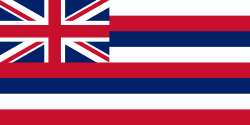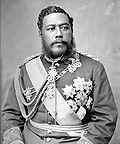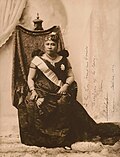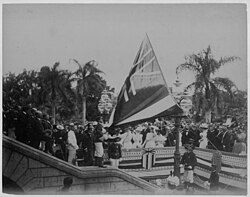Hawaiian Kingdom
The Hawaiian Kingdom, or Kingdom of Hawaiʻi, was a sovereign state located in the Hawaiian Islands.
Kingdom of Hawaiʻi Aupuni Mōʻī o Hawaiʻi | |||||||||||||||||
|---|---|---|---|---|---|---|---|---|---|---|---|---|---|---|---|---|---|
| 1795–1893 | |||||||||||||||||
| Motto: | |||||||||||||||||
| Anthem: | |||||||||||||||||
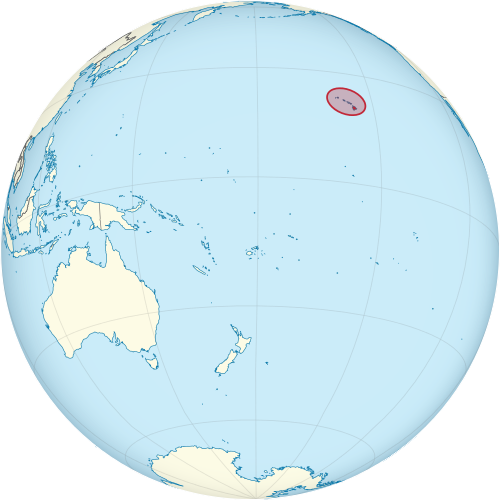 | |||||||||||||||||
| Capital | |||||||||||||||||
| Common languages | Hawaiian, English | ||||||||||||||||
| Religion | Church of Hawaii | ||||||||||||||||
| Demonym(s) | Hawaiian | ||||||||||||||||
| Government | Absolute monarchy (until 1840) Constitutional monarchy (from 1840) | ||||||||||||||||
| Monarch | |||||||||||||||||
• 1795–1819 | Kamehameha I | ||||||||||||||||
• 1819-1824 | Kamehameha II | ||||||||||||||||
• 1825-1854 | Kamehameha III | ||||||||||||||||
• 1855-1863 | Kamehameha IV | ||||||||||||||||
• 1863-1872 | Kamehameha V | ||||||||||||||||
• 1873-1874 | Lunalilo | ||||||||||||||||
• 1874-1891 | Kalakaua | ||||||||||||||||
• 1891–1893 | Liliʻuokalani | ||||||||||||||||
| Kuhina Nui | |||||||||||||||||
• 1819–1832 (first) | Kaʻahumanu | ||||||||||||||||
• 1863–1864 (last) | Kekūanāoʻa | ||||||||||||||||
| Legislature | Legislature | ||||||||||||||||
| House of Nobles | |||||||||||||||||
| House of Representatives | |||||||||||||||||
| History | |||||||||||||||||
• | May, 1795 | ||||||||||||||||
| March/April 1810[10] | |||||||||||||||||
| October 8, 1840 | |||||||||||||||||
| February 25 – July 31, 1843 | |||||||||||||||||
| November 28, 1843 | |||||||||||||||||
| August 22, 1849 - September 5, 1849 | |||||||||||||||||
• | January 17, 1893 | ||||||||||||||||
• Forced abdication of Queen Liliʻuokalani | January 24, 1895 | ||||||||||||||||
| Population | |||||||||||||||||
• 1780 | 400,000–800,000 | ||||||||||||||||
• 1800 | 250,000 | ||||||||||||||||
• 1832 | 130,313 | ||||||||||||||||
• 1890 | 89,990 | ||||||||||||||||
| Currency | |||||||||||||||||
| |||||||||||||||||
| Today part of | |||||||||||||||||
Establishment
The country was formed in 1795, when the warrior chief Kamehameha the Great, of the independent island of Hawaiʻi, conquered the independent islands of Oʻahu, Maui, Molokaʻi and Lānaʻi and unified them under one government. In 1810, the whole Hawaiian archipelago became unified when Kauaʻi and Niʻihau joined the Hawaiian Kingdom voluntarily. Two major dynastic families ruled the kingdom: the House of Kamehameha and the House of Kalākaua.
Recognition
Major European powers recognised the country. The United States became its chief trading partner and watched over it to prevent some other power (such as Britain or Japan) from threatening to seize control. Hawaiʻi was forced to adopt a new constitution in 1887. King Kalākaua signed it, because the Honolulu Rifles, an anti-monarchist militia, thratened him. Queen Liliʻuokalani, who succeeded Kalākaua in 1891, tried to replace the 1887 constitution with a new one. She was but was overthrown in 1893, largely at the hands of the Committee of Safety, a group of residents consisting of Hawaiian subjects and foreign nationals of American, British and German descent, many of whom had been educated in the US, had lived there for a time.[11] Hawaiʻi was an independent republic until the U.S. annexed it through the Newlands Resolution, on July 4, 1898. This created the Territory of Hawaii. United States Public Law 103-150 adopted in 1993 (informally known as the Apology Resolution), acknowledged that "the overthrow of the Kingdom of Hawaii occurred with the active participation of agents and citizens of the United States" and also "that the Native Hawaiian people never directly relinquished to the United States their claims to their inherent sovereignty as a people over their national lands, either through the Kingdom of Hawaii or through a plebiscite or referendum."[12]
Hawaiian Kingdom Media
Regional anthem of Hawaii and national anthem of Hawaiian Kingdom.
Hawaiian military officer, 1819 (by Jacques Arago)
King Kalākaua meeting U.S. President Grant at the White House, 1874
USS Boston's landing force on duty at the Arlington Hotel, Honolulu, at the time of the overthrow, January 1893
Lord George Paulet (1803–1879), the third son of Charles Paulet, 13th Marquess of Winchester became captain of the Royal Navy 28 December 1841. He put Hawaii under military occupation for six months of 1843. He was promoted to Rear Admiral 21 July 1856, retired in 12 March 1867 and died 22 November 1879.
On August 12, 1898, the flag of the Hawaiian Kingdom over ʻIolani Palace was lowered to raise the United States flag to signify annexation.
Kawaiahaʻo Church is known as the Westminster Abbey of Hawaiʻi, the site of coronations, royal christenings and funerals.
References
- ↑ Kanahele, George S. (1995). "Kamehameha's First Capital". [Hawaiian Kingdom at Google Books Waikiki, 100 B.C. to 1900 A.D.: An Untold Story]. University of Hawaii Press. pp. 90–102. ISBN 978-0-8248-1790-9.
{{cite book}}: Check|url=value (help) - ↑ [Hawaiian Kingdom at Google Books FAP-30 (Honoapiilani Highway) Realignment, Puamana to Honokowai, Lahaina District, Maui County: Environmental Impact Statement]. 1991. p. 14.
{{cite book}}: Check|url=value (help) - ↑ Trudy Ring; Noelle Watson; Paul Schellinger (5 November 2013). [Hawaiian Kingdom at Google Books The Americas: International Dictionary of Historic Places]. Routledge. p. 315. ISBN 978-1-134-25930-4.
{{cite book}}: Check|url=value (help) - ↑ Patrick Vinton Kirch; Thérèse I. Babineau (1996). [Hawaiian Kingdom at Google Books Legacy of the landscape: an illustrated guide to Hawaiian archaeological sites]. University of Hawaii Press. p. 63. ISBN 978-0-8248-1816-6.
{{cite book}}: Check|url=value (help) - ↑ Patricia Schultz (2007). [Hawaiian Kingdom at Google Books 1,000 Places to See in the USA and Canada Before You Die]. Workman Pub. p. 932. ISBN 978-0-7611-4738-1.
{{cite book}}: Check|url=value (help) - ↑ Bryan Fryklund (4 January 2011). [Hawaiian Kingdom at Google Books Hawaii: The Big Island]. Hunter Publishing, Inc. p. 81. ISBN 978-1-58843-637-5.
{{cite book}}: Check|url=value (help) - ↑ Benjamin F. Shearer (2004). [Hawaiian Kingdom at Google Books The Uniting States: Alabama to Kentucky]. Greenwood Publishing Group. p. 296. ISBN 978-0-313-33105-3.
{{cite book}}: Check|url=value (help) - ↑ Roman Adrian Cybriwsky (23 May 2013). [Hawaiian Kingdom at Google Books Capital Cities around the World: An Encyclopedia of Geography, History, and Culture: An Encyclopedia of Geography, History, and Culture]. ABC-CLIO. p. 352. ISBN 978-1-61069-248-9.
{{cite book}}: Check|url=value (help) - ↑ [Hawaiian Kingdom at Google Books Engineering Magazine]. Engineering Magazine Company. 1892. p. 286.
{{cite book}}: Check|url=value (help) - ↑ Kuykendall, Ralph Simpson (1965) [1938]. The Hawaiian Kingdom 1778–1854, Foundation and Transformation. Vol. 1. Honolulu: University of Hawaii Press. p. 51. ISBN 0-87022-431-X.
- ↑ Schulz, Joy (2017). Hawaiian by Birth: Missionary Children, Bicultural Identity, and U.S. Colonialism in the Pacific. University of Nebraska Press. pp. 1–238. ISBN 978-0803285897.
- ↑ "Public Law 103-150 - Wikisource, the free online library".
